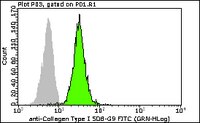FCMAB412F Sigma-AldrichMilli-Mark® Anti-Collagen Type I-FITC Antibody, clone 5D8-G9
Milli-Mark Anti-Collagen Type I-FITC Antibody, clone 5D8-G9 is an antibody against Collagen Type I for use in FC.
More>> Milli-Mark Anti-Collagen Type I-FITC Antibody, clone 5D8-G9 is an antibody against Collagen Type I for use in FC. Less<<Recommended Products
Overview
| Replacement Information |
|---|
Key Spec Table
| Species Reactivity | Key Applications | Host | Format | Antibody Type |
|---|---|---|---|---|
| H | FC | M | FITC | Monoclonal Antibody |
| References |
|---|
| Product Information | |
|---|---|
| Format | FITC |
| Control |
|
| Presentation | Purified mouse monoclonal IgG1 conjugated to FITC in PBS with 0.1% sodium azide and 15 mg/mL BSA. |
| Quality Level | MQ100 |
| Applications | |
|---|---|
| Application | Milli-Mark Anti-Collagen Type I-FITC Antibody, clone 5D8-G9 is an antibody against Collagen Type I for use in FC. |
| Key Applications |
|
| Physicochemical Information |
|---|
| Dimensions |
|---|
| Materials Information |
|---|
| Toxicological Information |
|---|
| Safety Information according to GHS |
|---|
| Safety Information |
|---|
| Storage and Shipping Information | |
|---|---|
| Storage Conditions | Maintain refrigerated at 2-8 °C protected from light in undiluted aliquots for up to 6 months from date of receipt. |
| Packaging Information | |
|---|---|
| Material Size | 100 tests |
| Transport Information |
|---|
| Supplemental Information |
|---|
| Specifications |
|---|
| Global Trade Item Number | |
|---|---|
| Catalogue Number | GTIN |
| FCMAB412F | 04053252536816 |
Documentation
Milli-Mark® Anti-Collagen Type I-FITC Antibody, clone 5D8-G9 MSDS
| Title |
|---|







